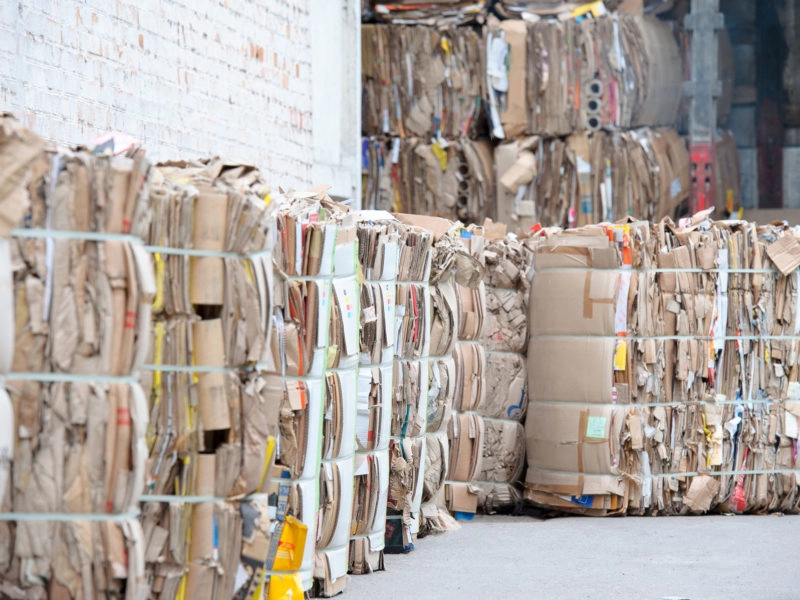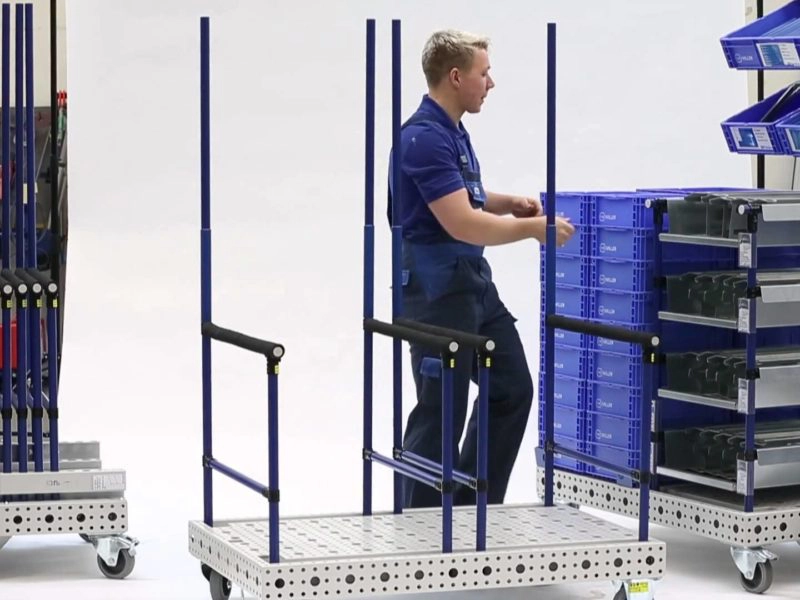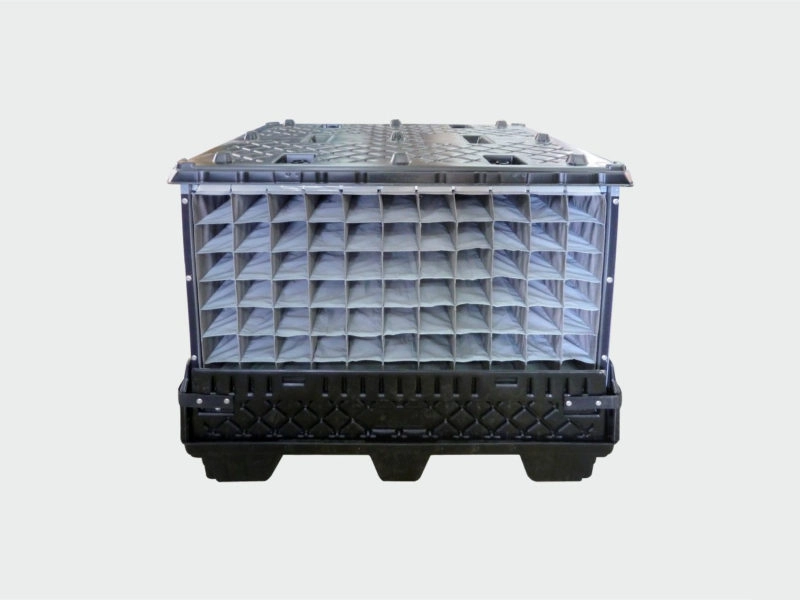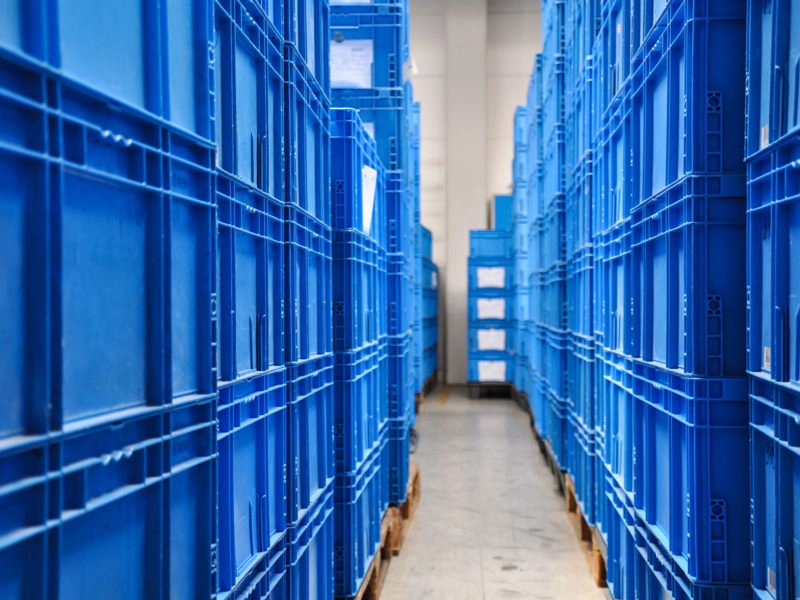Returnable & Reusable Packaging vs One-way Packaging
When it comes to packaging solutions, Logimarkt stands out as a partner committed to improving brand perception. This means streamlining logistics processes and reducing costs through improved packaging strategies. We strive to optimize packaging options for your products and focus on providing sustainable, cost-effective and brand-boosting solutions.
The shift towards eco-friendly practices has increased the preference for returnable and reusable packaging. This aligns with global green initiatives and reduces disposal costs. We are pleased to provide you with information on the many benefits related to this approach.
Optimizing Packaging Costs
Plastic containers and pallets are durable and reusable. They offer prolonged usage (5-10 years) and are versatile across projects.
At the same time, the robustness of plastic packaging minimizes losses linked to spoilage. They perform better than traditional cardboard in terms of resistance to moisture and contamination. Plastic containers filled with dunnage ensure optimal protection during transport.
Reducing Packaging Waste
Cardboard is a major contributor to landfill waste. Reusable plastic containers, on the other hand are a better and sustainable choice. They further eliminate disposable materials.
Plastic containers offer multiple applications and transport cycles. Their longevity and durability make them an eco-friendly option that helps reduce waste. They further align with global efforts for a healthier future.
Efficient Transportation
Returnable packaging helps reduce transport costs. This is due to volume standardization, efficient stacking and modular designs. The nesting or folding features of plastic packaging optimizes space, which reduces transport costs.
Enhancing Brand Image and Customer Loyalty
Branded and clean returnable and reusable packaging serves as an emblem for your brand. Compared to one-way packaging, customers appreciate the hassle-free experience and positive impact on the environment. This fosters customer loyalty and enhances brand image.
Organized Workspaces
In workspaces, cardboard packaging associates with clutter and mess. In contrast, returnable packaging is a superior solution for maintaining a clean and organized space. The use of cardboard can lead to reduced workspace due to clutter. This is in particular detrimental to dust-sensitive components.
In contrast, the adoption of returnable packaging guarantees a hygienic workspace. It’s a clean and tidy working environment that promotes a safer environment. This shift from cardboard or wooden packaging enhances cleanliness. In addition, it contributes to a more efficient and safer space for operators.
Opting for reusable plastic packaging means opting for clean, organized workspaces.
Lean Manufacturing
The adoption of an ordered and uniform packaging solution is essential to strengthen cost-free production methods. This approach improves stock control and minimizes stock levels. It facilitates a smooth production flow, streamlines processes and improves storage space.
Fabrication companies tend to use reusable and returnable packaging. This is a move that leads to a re-think and upgrade of parts and products entering the production phase. This results in the removal of buffer zones. The adoption of lean principles ensures well-optimized internal flows and space use. One such example is the modular plastic container system known as “Kanban” or “just in time”.
An additional advantage comes from the use of colour coding. This enhances process management.
Returnable and reusable plastic containers offer an extra level of efficiency. They offer a tracking and tracing system. The use of label holders or pad label holders simplifies the removal of self-adhesive labels. Some containers can even incorporate RFID electronic tracking chips for full monitoring and location features.
Enhancing Operator Safety, Productivity, and Ergonomics
A range of features is available to improve workflows and reduce accidents. This leads to improved safety and production. The key benefits include optimized stacking, simplified handling and colour-coded systems. These, along with the integration of handles and doors into reusable packaging, offer custom options. These innovations aim to reduce reports of sprains or muscular and skeletal disorders among operators. The collective impact of these improvements results in a safer and more efficient working environment. In the end, it boosts overall output.
Producers incur substantial annual costs related to workers’ compensation and healthcare. The use of reusable packaging with improved ergonomics increases worker safety. In addition, it contributes to improved financial performance, as well. The focus on ergonomics is a strategic move to create a workplace that protects operators’ well-being. It has a positive impact on overall efficiency in operations.
Boosted Operational Speed for Operators
Having a clean and organized production area and warehouse has a direct impact on the speed of operators. Reduced time spent handling and locating products is a key advantage. Cutting out the slow process of handling and disposing of dirty disposable packaging is a thing of the past. This streamlined approach ensures that every operation runs faster. The result is a reduction in cycle times.
The improvement in operation efficiency optimizes the workflow. It further contributes to the company’s overall financial performance. Faster processes translate into cost savings. This makes the business more agile and responsive to market’s demands.
Reduced Labor Costs Through Handling Standardization
Implementing a standardized handling approach leads to a substantial reduction in labour costs. A key element is the reduction in the need to use one-way cardboard separators. Plastic bags or other expandable packaging materials are removed. Plastic containers, designed for standardized stacking, increase safety. They allow higher stacking levels as well.
Increased efficiency in receiving and inspecting goods comes from standardized packaging. Faster and easier handling during these critical phases speeds up overall production processes. It results in substantial savings in labour costs. The streamlined approach ensures a more cost-effective and efficient use of resources. In addition, it has a positive impact on the final result.
Maximizing Returns On Investment
Investing in returnable packaging is a strategic cost-based financial move. It promises a high return on investment (ROI). Disposable packaging might be referred to as a full expense with zero ROI. In contrast, returnable packaging offers a continuous cycle of savings and profit.
Returnable packaging contributes to the total return on investment from the purchase price. Over time, they generate profits, as well. Repeated use cycles improve your company’s bottom line. In addition, they exceed their original expected lifetime. Product longevity allows companies to continue to operate or reuse the product. It offers long-term financial benefits. In contrast, disposable packaging has a one-off cost, with no option of return. As a result, returnable packaging is a smart and profitable choice for long-term financial success.
Eco-Friendly Packaging: The Sustainable Choice
We promote sustainability by offering returnable plastic packaging solutions. These are the result of a by-product of oil processing. In contrast, disposable packaging uses natural raw materials such as wood or cellulose. These materials originate from cutting down trees, which contributes to resource depletion. Opting for plastic packaging derived from oil by-products ensures a sustainable choice that does not compromise valuable natural resources.
At Logimarkt, our commitment goes beyond the present. We design returnable packaging that is ready for the future. These solutions are adaptable for future projects. They are also designed to withstand 5-10 years of heavy use. Choosing our returnable packaging joins your business in eco-conscious practices, contributing to a greener and more sustainable future.











